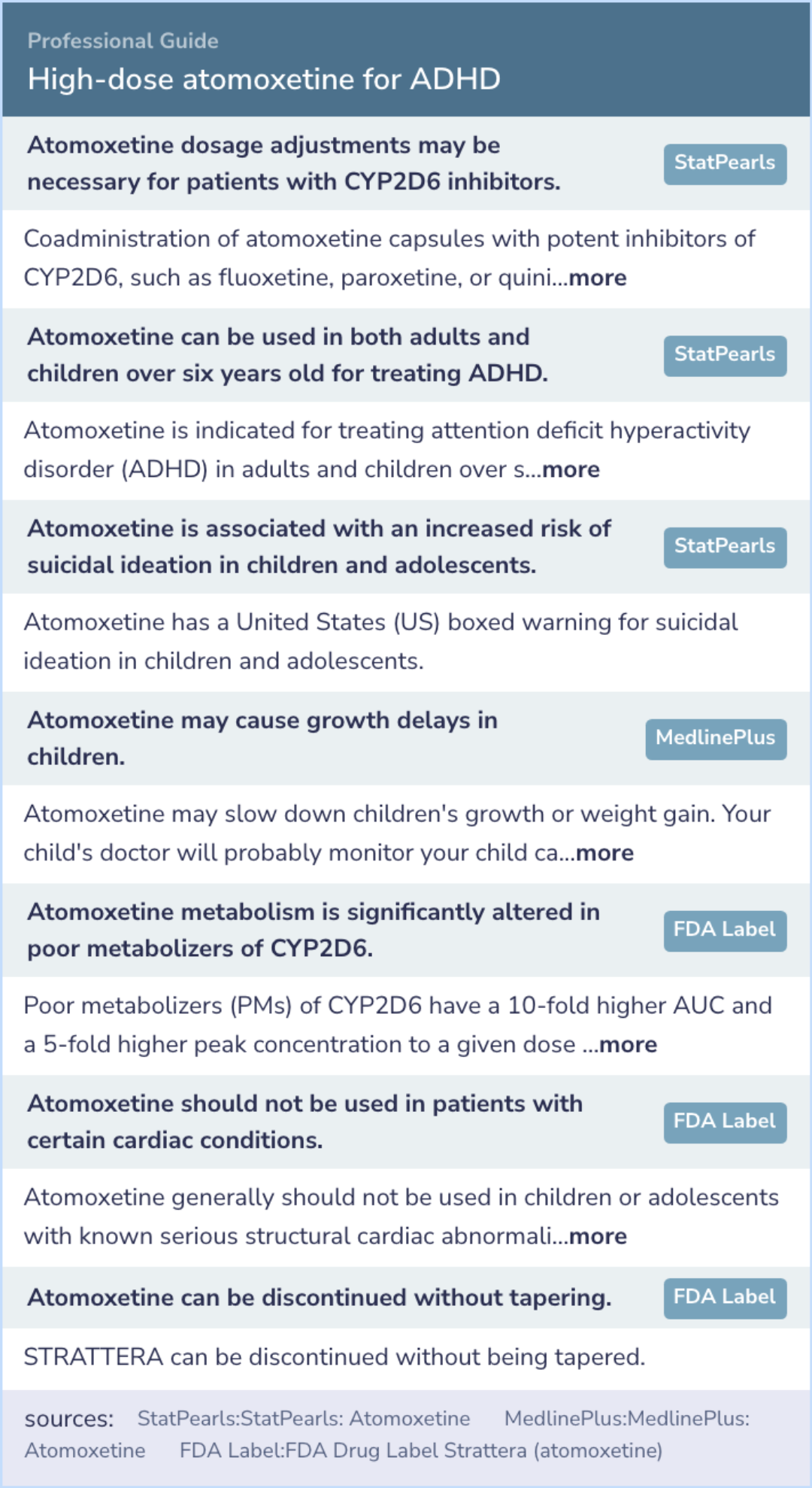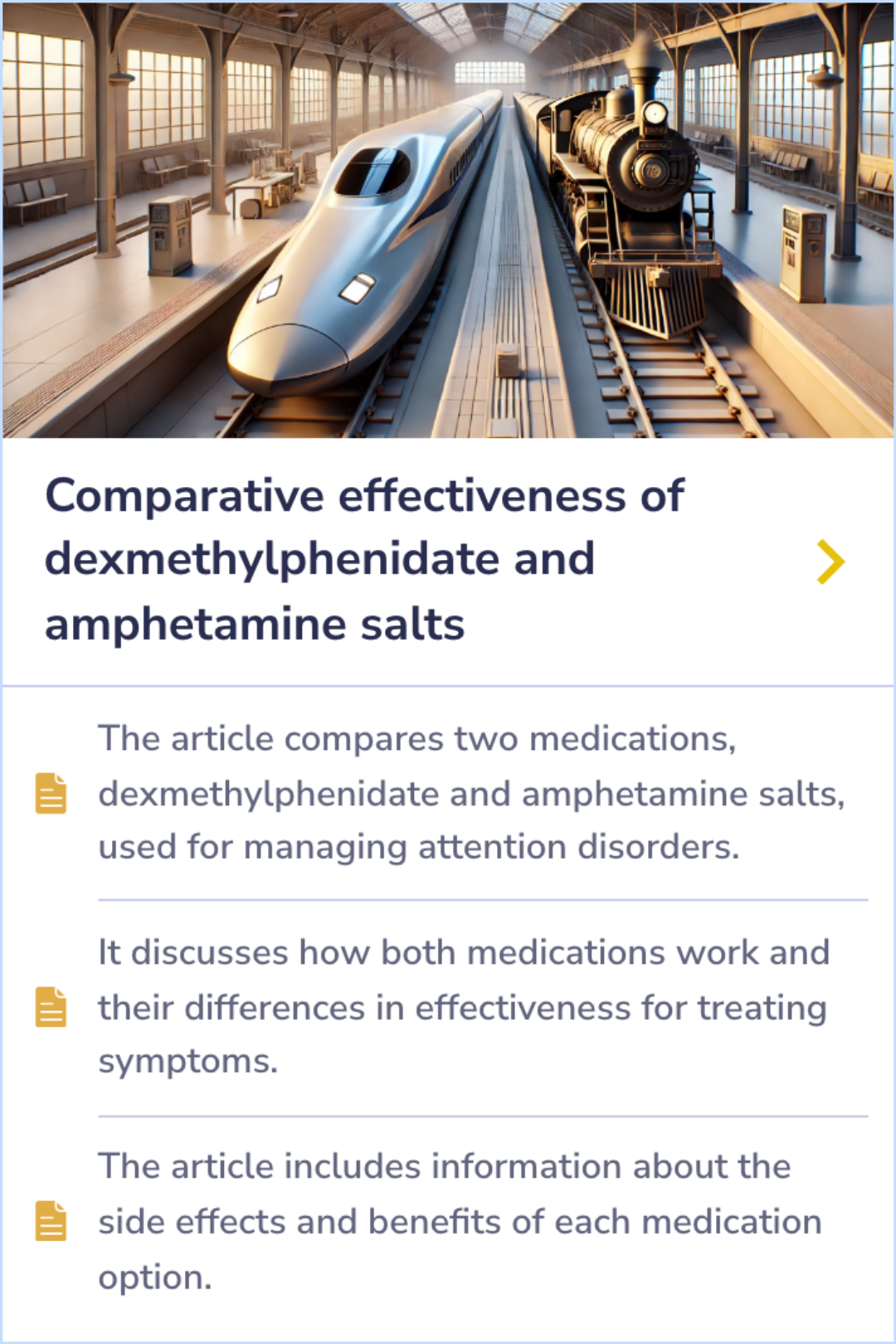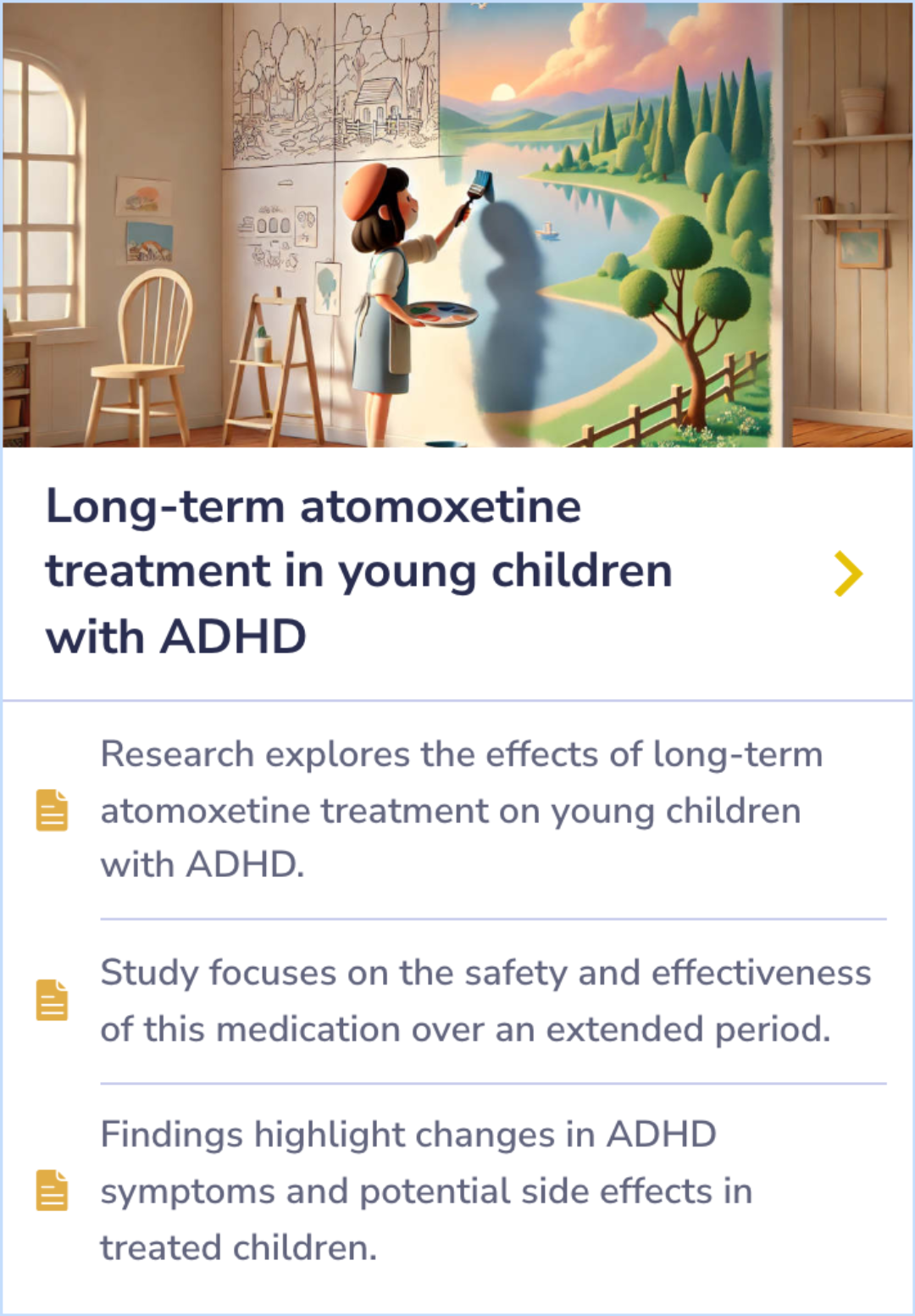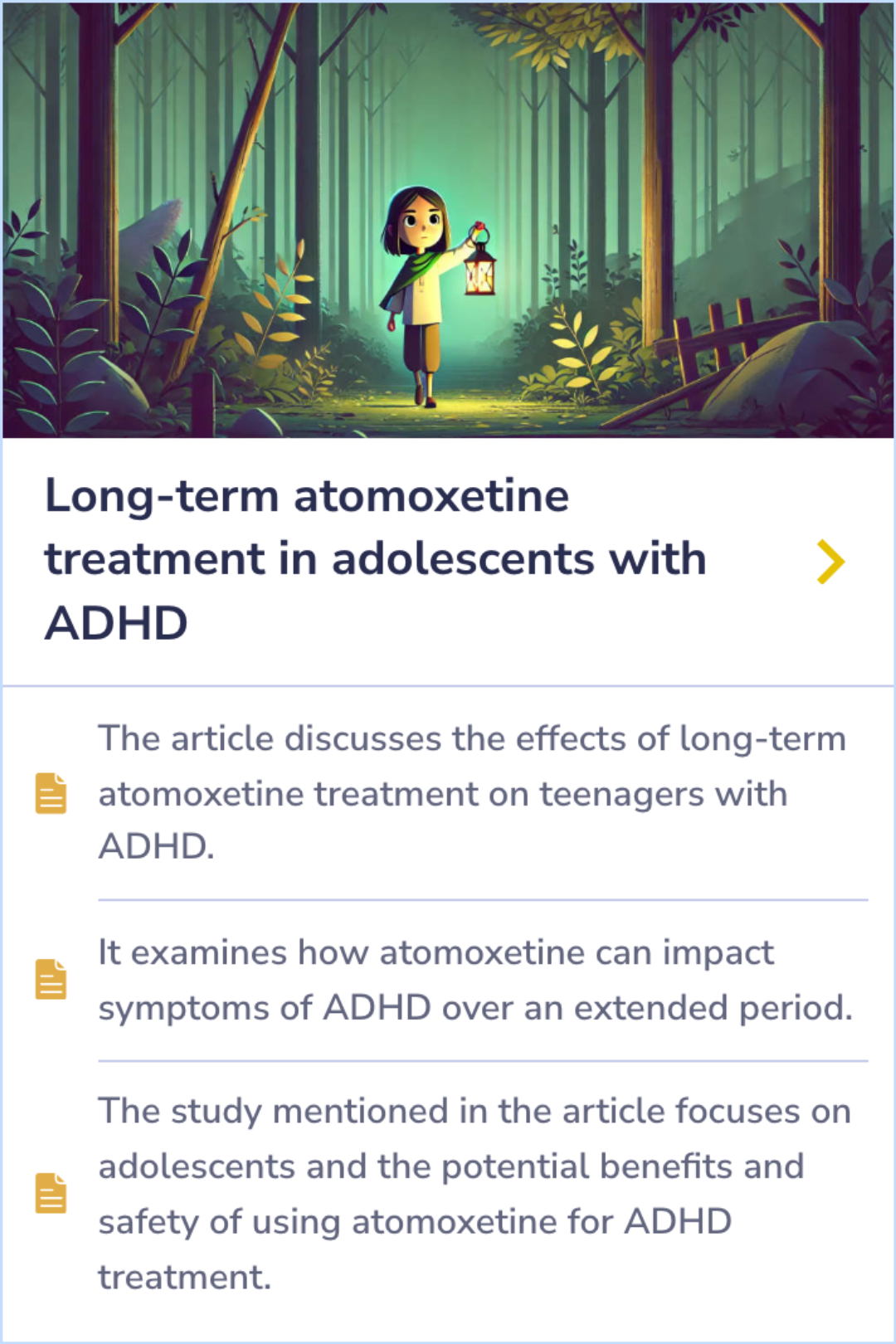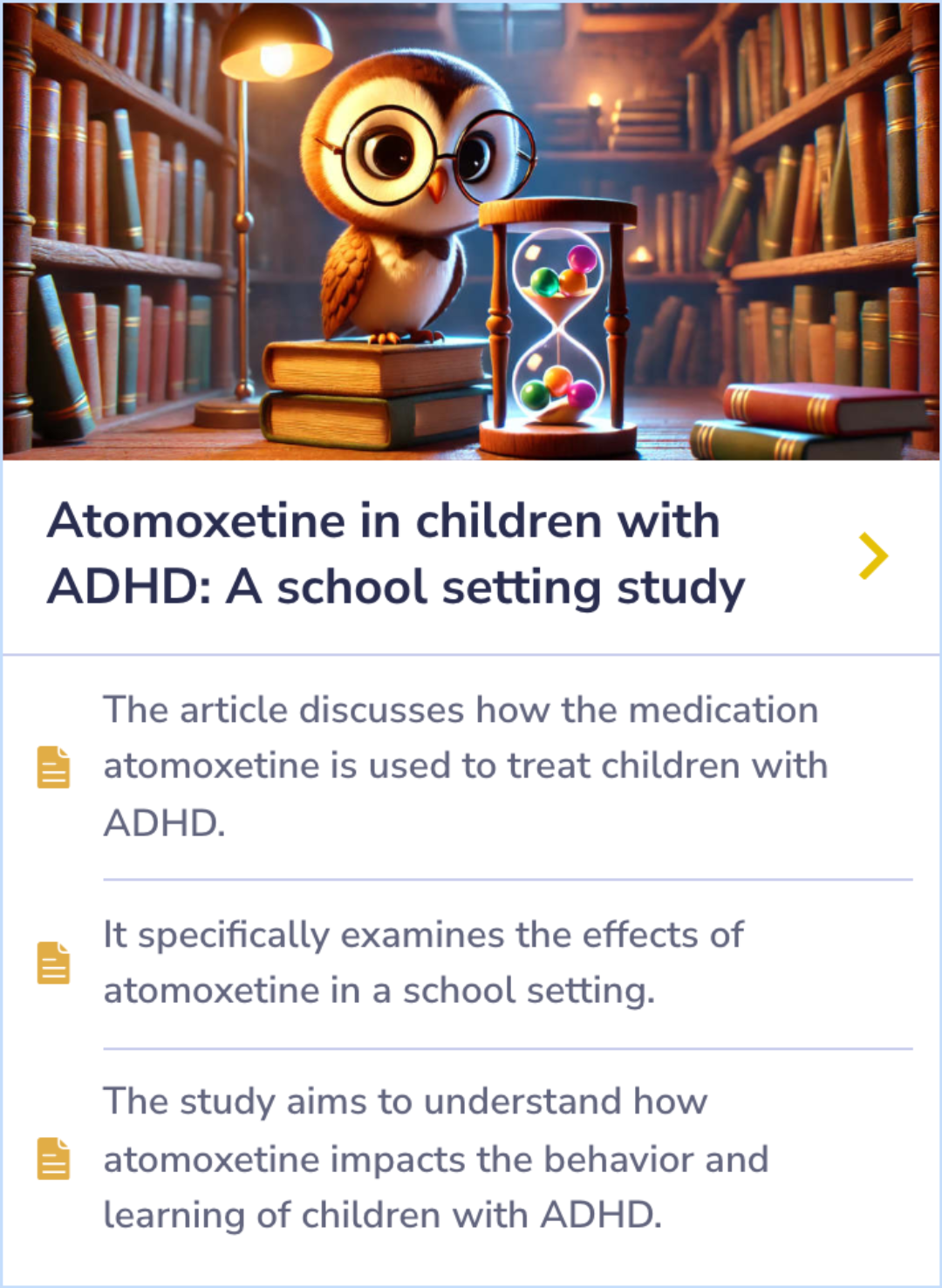Strattera Paper Database
Visual Abstract
High-dose atomoxetine treatment of ADHD in youths with limited response to standard doses
High-dose atomoxetine for ADHD
October 25, 2024
author
Kratochvil CJ, Michelson D, Newcorn JH, Weiss MD, Busner J, Moore RJ, Ruff DD, Ramsey J, Dickson R, Turgay A, Saylor KE, Luber S, Vaughan B, Allen AJ
journal
J Am Acad Child Adolesc Psychiatry
Date Published
2007 Sep
Why link to a visual abstract?
What is a visual abstract?
Original
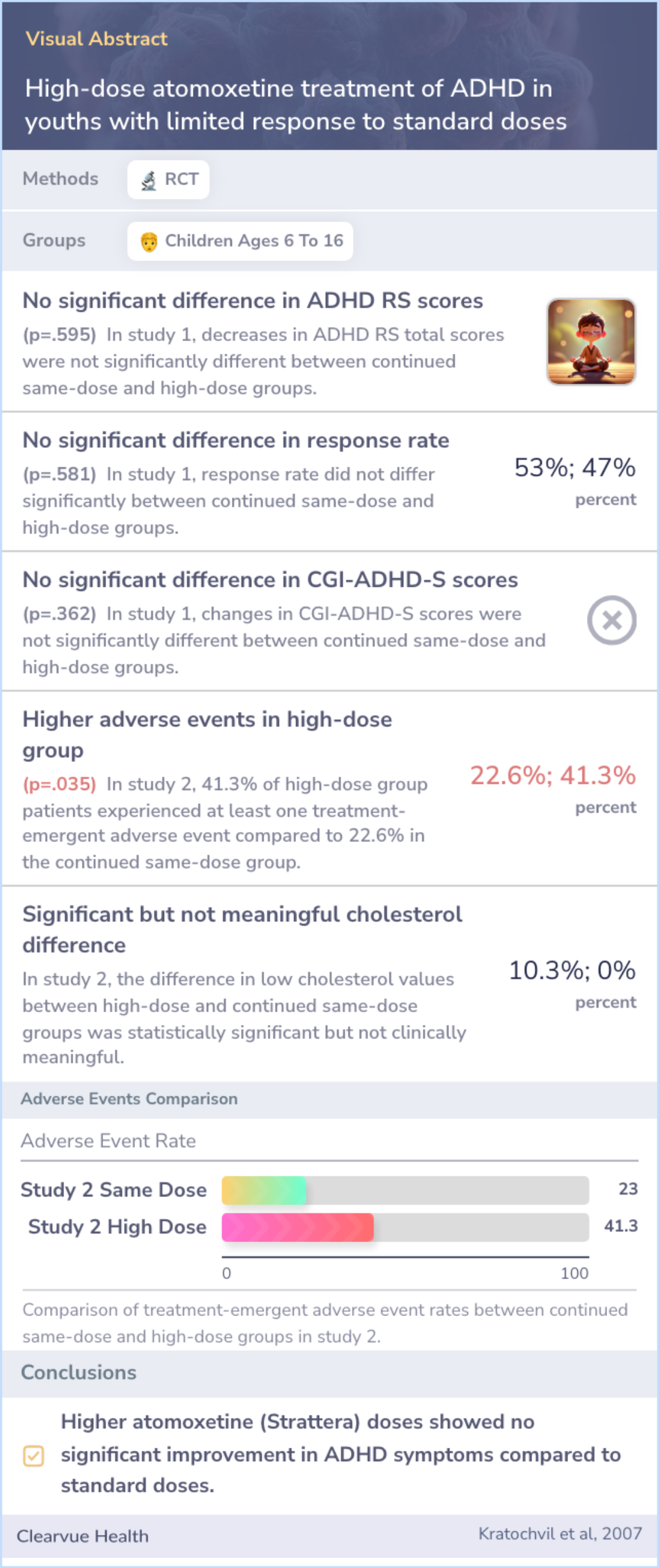
Study Summary
🔬
What They Studied
They studied whether higher than standard doses of atomoxetine (Strattera) improve the treatment of ADHD in children and adolescents who do not respond well to standard doses.
💡
What They Found
The study found that increasing the dose of atomoxetine (Strattera) does not significantly improve ADHD symptoms nor affect tolerability compared to maintaining the standard dose.
📚
What This Means
The findings suggest that current dosing guidelines for atomoxetine (Strattera) are suitable for most patients, with no additional benefit observed in increasing the dose beyond the recommended levels.
Study Summary
Study Overview
Researchers explored the effectiveness of atomoxetine, a medication for ADHD, and whether higher doses could improve results for those not responding to standard doses. They discovered that while patients often benefited from continued treatment, raising the dose did not necessarily lead to better results compared to keeping the same dose.
The studies highlight that treatment progress can still occur over time, suggesting that sticking with current doses might be sufficient for many patients.
The studies highlight that treatment progress can still occur over time, suggesting that sticking with current doses might be sufficient for many patients.
Abstract: background
To assess the utility and tolerability of higher than standard atomoxetine doses to treat attention-deficit/hyperactivity disorder (ADHD).

Clinical Trial Findings
"Data from the studies presented here provide evidence that the current dose recommendations are appropriate for most patients and suggest that there is generally no systematic advantage to increasing the dose of atomoxetine beyond current guidelines."
Treatment and Response
"Overall, continued same-dose and high-dose treatments with atomoxetine were safe and reasonably well tolerated, with only modest differences in tolerability and vital signs between treatment groups."
Importance of Dose
"Although increased length of time on treatment was associated with better response, increased dose was not."
Study Summary
Methods
Two clinical trials were conducted involving children and adolescents aged 6 to 16 who did not respond to the standard dose of Strattera (atomoxetine). The participants were randomly assigned to either continue on the same dose or to receive a higher dose.
One trial tested doses up to 3.0 mg/kg/day, while the other tested doses up to 2.4 mg/kg/day. The trials were double-blind, meaning neither the participants nor the researchers knew who received which dose.
One trial tested doses up to 3.0 mg/kg/day, while the other tested doses up to 2.4 mg/kg/day. The trials were double-blind, meaning neither the participants nor the researchers knew who received which dose.
Abstract: methods
Two randomized, double-blind trials of atomoxetine nonresponders ages 6 to 16 years were conducted comparing continued treatment with same-dose atomoxetine to treatment using greater than standard efficacious doses (study 1: up to 3.0 mg . kg . day; ...more

Study Summary
Results
The study found that increasing the dose of Strattera (atomoxetine) did not lead to significantly better outcomes in ADHD symptom reduction compared to staying on the standard dose. Both groups showed similar improvements in their ADHD Rating Scale scores.
Furthermore, the higher doses were generally well-tolerated, with no significant differences in side effects between the standard and higher doses across the participants in both studies.
Furthermore, the higher doses were generally well-tolerated, with no significant differences in side effects between the standard and higher doses across the participants in both studies.
Abstract: results
The primary outcome measure for both studies was mean ADHD Rating Scale (ADHD RS) total score. For study 1 (N = 122), decreases in ADHD RS total scores were not significantly different between treatment groups (mean change [SD]: continued same dose, ...more
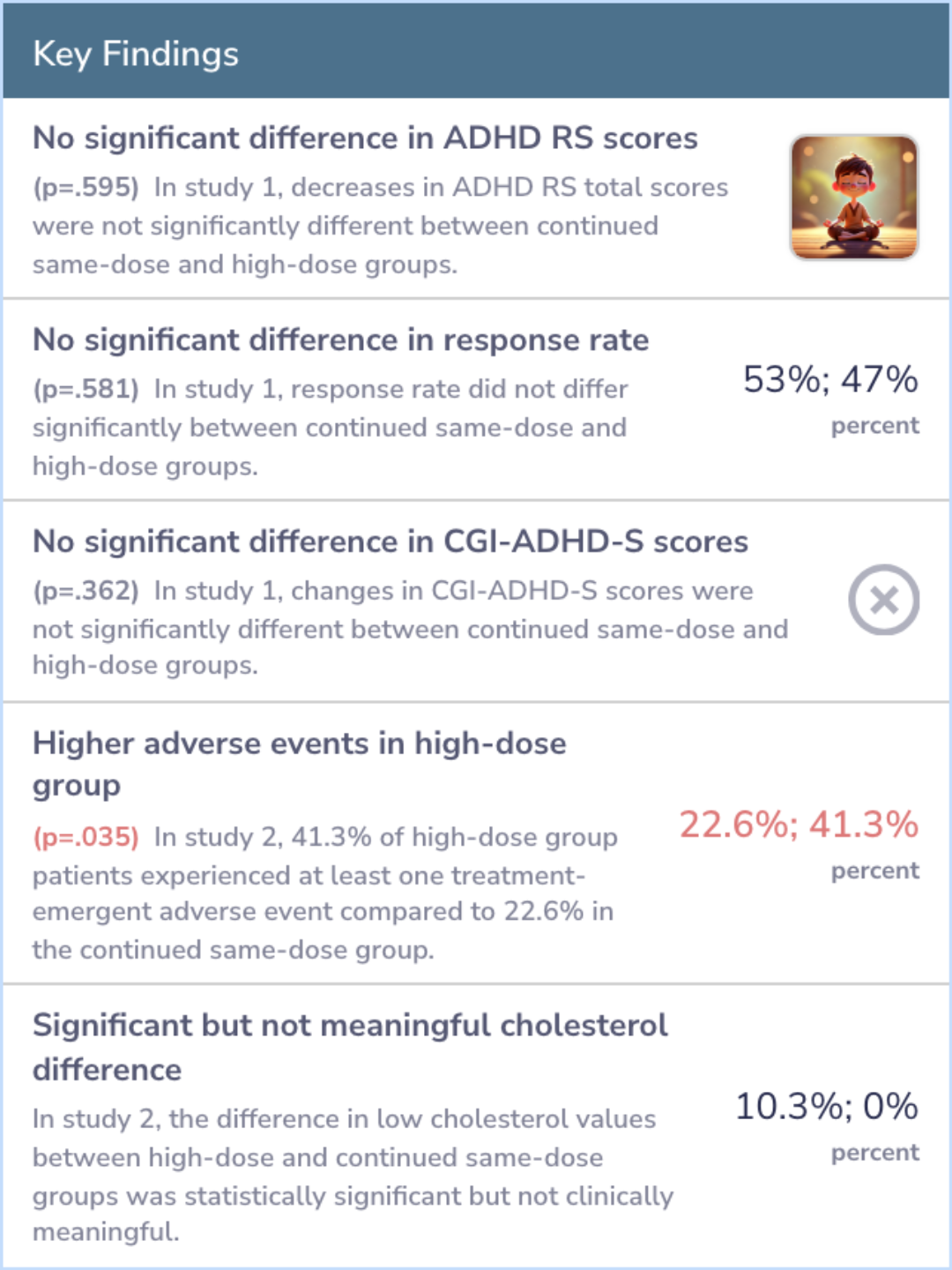
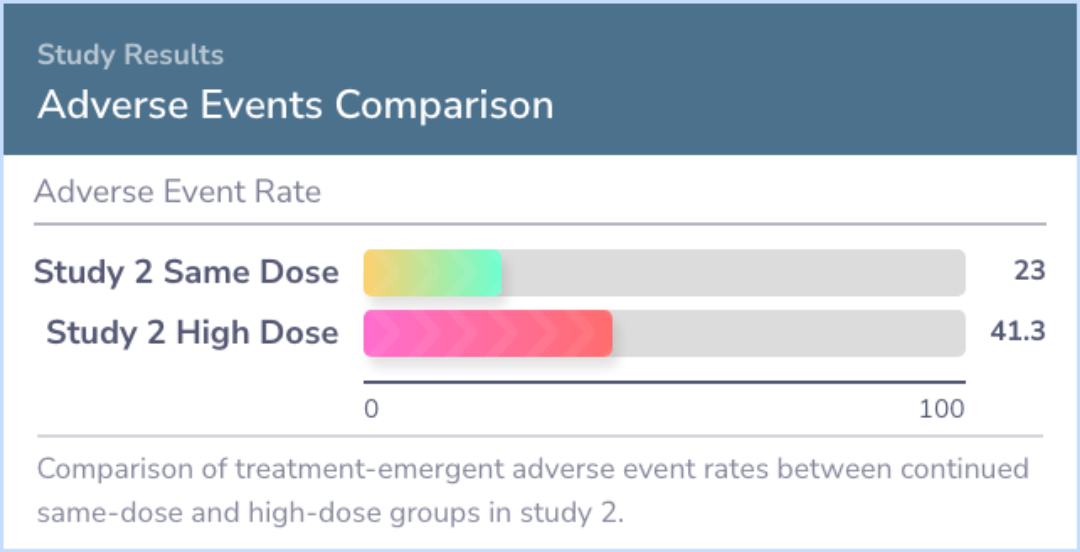
Study Summary
Conclusions
The findings suggest that sticking to the recommended dose of Strattera (atomoxetine) is sufficient for most patients with ADHD. There was no clear benefit in increasing the dose beyond the standard guidelines.
While continued treatment, whether at a higher or the same dose, showed improvement in those who initially didn’t respond, the lack of a placebo group means we cannot rule out the influence of expectations on the observed improvements.
While continued treatment, whether at a higher or the same dose, showed improvement in those who initially didn’t respond, the lack of a placebo group means we cannot rule out the influence of expectations on the observed improvements.
Abstract: conclusions
These studies provide evidence that current dose recommendations are appropriate for most patients, suggesting no systematic advantage to increasing atomoxetine doses beyond current guidelines. In both studies, continued treatment, whether at a highe...more
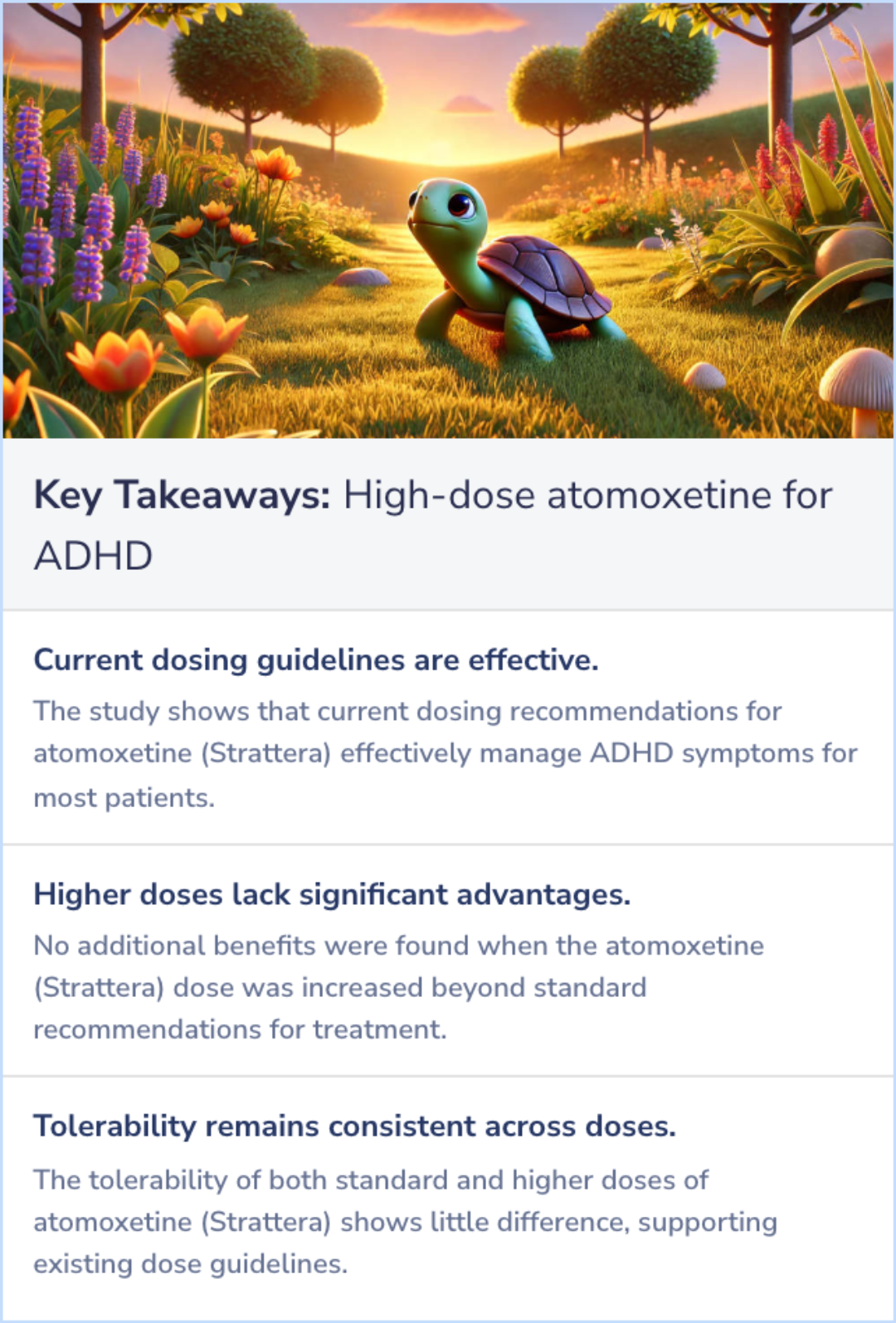
Background Information
Patient Guide
💊
FDA approval and age
Strattera is FDA-approved for ADHD treatment in individuals over six years old, including children and adults.
⚙️
Mechanism of action
Atomoxetine acts as a selective norepinephrine reuptake inhibitor, influencing norepinephrine and dopamine in specific brain areas.
🔢
Dosing guidelines
Initial child dosing is weight-based, with max daily dose set at 100 mg. Changes apply based on metabolizer status.
📈
Adverse effects monitoring
Patients on Strattera require monitoring for psychiatric symptoms, cardiovascular risks, and liver function changes.
📏
Special precautions
Children need regular growth checks as Strattera may impact height and weight. Psychiatric monitoring is key.
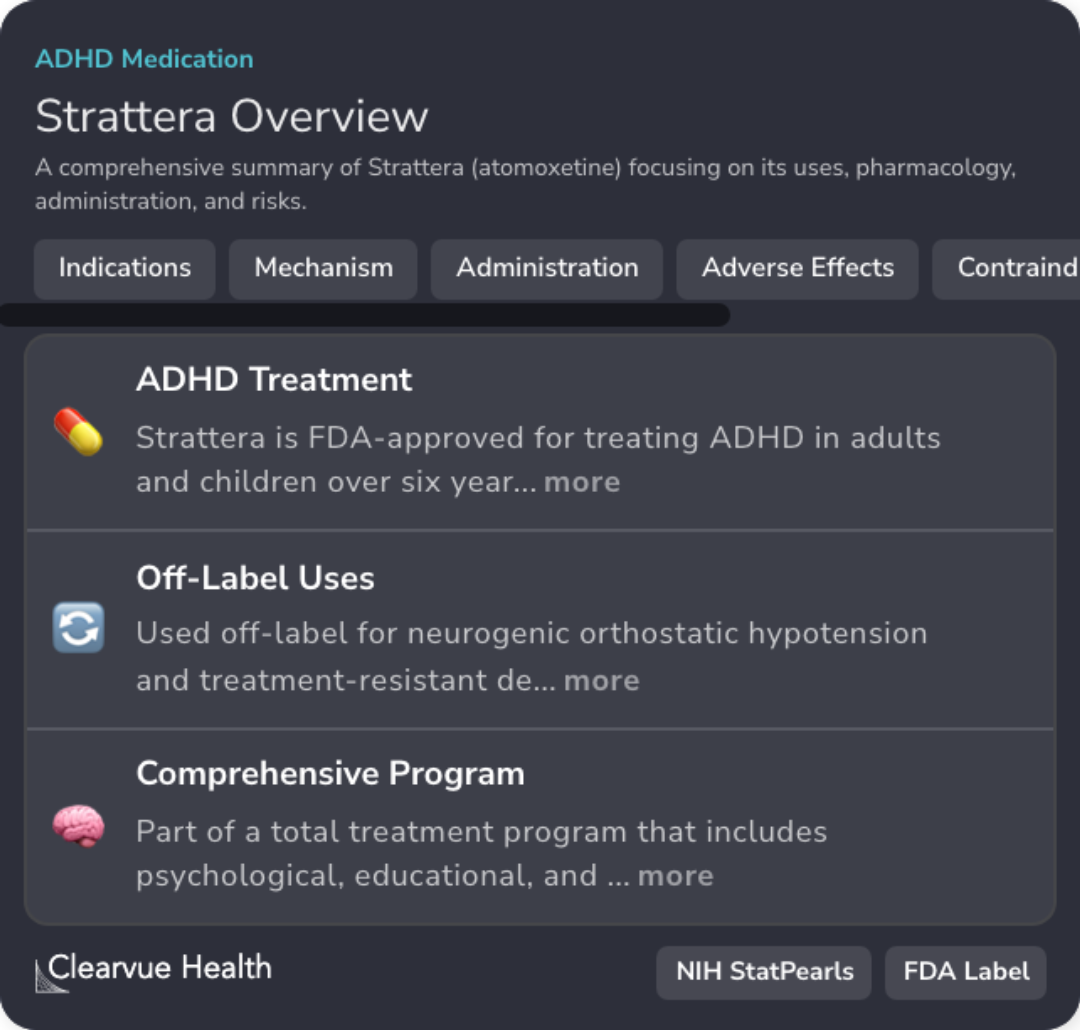
Professional Guide
Expert Opinion: High-dose atomoxetine for ADHD
In line with findings that higher atomoxetine doses show no systematic advantage, clinicians must monitor for dosage adjustments in CYP2D6 poor metabolizers.
Treatment of ADHD with atomoxetine spans from children over six to adults, though caution is advised due to its association with increased risk of suicidal ideation in younger patients.
Close monitoring for potential psychiatric symptoms and growth delays in children is paramount.
Atomoxetine's impact on cardiac health should be carefully considered in those with underlying cardiac conditions.
Treatment of ADHD with atomoxetine spans from children over six to adults, though caution is advised due to its association with increased risk of suicidal ideation in younger patients.
Close monitoring for potential psychiatric symptoms and growth delays in children is paramount.
Atomoxetine's impact on cardiac health should be carefully considered in those with underlying cardiac conditions.
Evidence Summary
Comparing Dexmethylphenidate and Amphetamine Salts
The discussion dives into two medications, dexmethylphenidate and amphetamine salts, highlighting how they differ in addressing attention disorders. It explores the efficiency of each in symptom management, providing insights into their unique benefits and side effects.
Examining these differences helps readers contrast the mechanisms and outcomes of these treatments for better understanding of treatment nuances in attention disorders.
Examining these differences helps readers contrast the mechanisms and outcomes of these treatments for better understanding of treatment nuances in attention disorders.
Evidence Summary
Understanding Long-Term Effects of ADHD Treatment
Long-term treatment with this medication reveals important insights about its safety and effectiveness in young children with ADHD. Observations highlight how symptoms change over time, providing a clear picture of the medication's impact on daily life. Tracking side effects is equally crucial, as it ensures that the benefits of treatment are carefully weighed against any potential drawbacks, ultimately contributing to a comprehensive understanding of ongoing care for these children.
Examining these factors helps clarify the overall journey of children undergoing treatment, shedding light on the nuances of managing ADHD effectively. Continuous monitoring allows for a deeper appreciation of how these young patients respond to therapy, emphasizing the need for thoughtful assessment throughout their treatment.
Examining these factors helps clarify the overall journey of children undergoing treatment, shedding light on the nuances of managing ADHD effectively. Continuous monitoring allows for a deeper appreciation of how these young patients respond to therapy, emphasizing the need for thoughtful assessment throughout their treatment.
Evidence Summary
Prolonged Atomoxetine Use in Teens with ADHD: Effects on Symptoms Over Time
The article examines the impact of long-term atomoxetine use on teenagers with ADHD, focusing on its effects over an extended period. It evaluates how this medication influences symptoms and discusses the potential benefits and safety for adolescents undergoing treatment.
Through this lens, the text highlights the continuous monitoring of symptom changes in teenagers, emphasizing the role of atomoxetine in managing ADHD symptoms over time.
Through this lens, the text highlights the continuous monitoring of symptom changes in teenagers, emphasizing the role of atomoxetine in managing ADHD symptoms over time.
Evidence Summary
Atomoxetine’s Role in School Settings for Children with ADHD
This study investigates how atomoxetine affects children with ADHD in school settings. By focusing on behavior and learning, the study aims to provide insights into the medication’s impact beyond clinical environments. Researchers looked at real-world classroom dynamics to see how treatment influences academic performance and social interactions.
It highlights how atomoxetine is used to manage symptoms in educational contexts, giving a broader perspective on its efficacy in helping children with ADHD thrive in school.
It highlights how atomoxetine is used to manage symptoms in educational contexts, giving a broader perspective on its efficacy in helping children with ADHD thrive in school.
